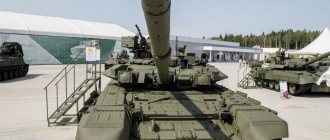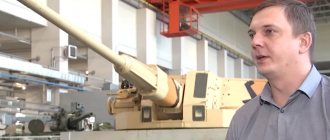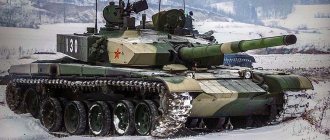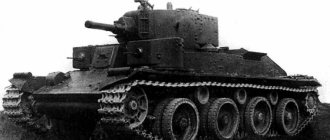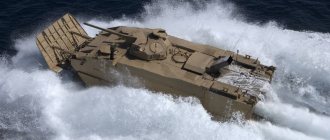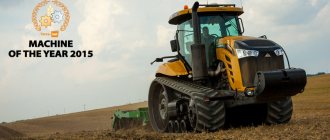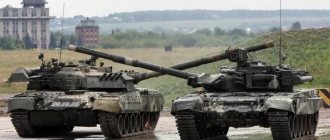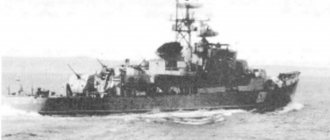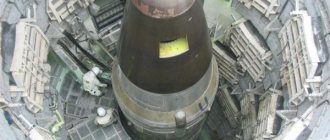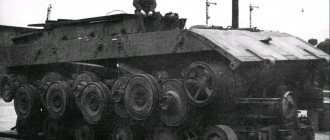The T-90 Vladimir is a main battle tank created in the late 1980s. It is essentially an almost complete modernization of the T-72B, and was even originally called “T-72B improved.”
In the first decade of the 21st century, it was the world's best-selling new main battle tank.
Description
Surveillance and communications equipment
A new turret was installed, equipped with a Kalina fire control system with an integrated tactical level combat information and control system.
The commander's panoramic sight contains two-plane independent field of view stabilization, a laser rangefinder, and television and thermal imaging channels. The multi-channel operator-gunner's sight "Sosna-U" has two-plane independent stabilization of the field of view, sighting and thermal imaging channels, a laser rangefinder and a laser channel for controlling a guided weapons complex.[10]
Armament and armor
A new automatic loader and a modernized 2A46M-5 gun were installed, as well as a remote-controlled 7.62-mm UDP T05BV-1 anti-aircraft gun. Particular attention has been paid to improving the commander's target acquisition and fire control capabilities, which are now equally effective both day and night.[11]
The ammunition is placed in 2 stowage groups: 1 inside the tank and 1 outside, 22 shots are located in the automatic loader, in the lower part of the hull, another 8 in non-mechanized stowage near the partition of the engine compartment, the remaining shots and charges for them are located in an armored box located at the stern of the tower.
Only the T-90AM has active protection. It partially uses components of the Afghanit active protection complex, which is fully installed on the promising T-14 tank. In the export version of the tank - T-90MS - the Arena-E KAZ can be installed at the customer's request. It has the same principle of operation, but more limited functionality.[12]
Dynamic protection "Relic" was installed instead of "Contact-5". The anti-neutron plate was removed and replaced with fire-resistant anti-fragmentation material such as Kevlar, and the fire extinguishing system was improved.[11]
Engine and control
The V-92S2F engine has a new pump and injectors, reinforced connecting rods and pins, a strengthened crankcase design, and improved casting quality. Nitriding began to be used in the production of the crankshaft. Improved air purifier with increased resource. The crew protection and warning system in case of abnormal engine operation has been updated. The V-92S2F starts at a minimum cold start temperature of −20 °C. Trigger amplitude ranges from −50 °C to +50 °C. The maximum operating altitude is up to 3000 meters above sea level. Engine weight - 1.07 tons. Specific power 0.72 kW/kg (0.98 hp/kg). The exhaust system is located in the fender pipe to reduce hull temperature and reduce the visibility of the tank to IR guidance systems. Unlike the previous diesel engines V-46, V-84 and V-92 with a separate mechanical transmission, the new engine is made in a single unified unit with an automatic transmission.[13][14]
For the first time in a Russian main tank, steering wheel-based control and an automatic gear shift system with the ability to switch to manual were used.[11] To improve mobility and maneuverability, the modernized tank is equipped with a new combined night vision device for the driver and a rearview camera.
History of the T-90
In 1989, a deep modernization project for the T-72B was created at the Nizhny Tagil UKBTM, which received the factory designation “Object 188”. In the same year, the tank was sent for testing, which it passed very successfully.
In parallel with Object 188, a more advanced Object 187 was being developed. However, they did not have time to finalize the latter - Object 188 was ordered to be put into service at the end of March 1991, and work on 187 was stopped.
After several improvements, it was decided to put the tank into service in October 1992, giving it the name T-90.
Story
Pre-war time
On July 18, 1929, the Revolutionary Military Council of the USSR adopted the “System of tank-tractor and auto-armored weapons of the Workers’ and Peasants’ Red Army”
I. To approve the following armored weapon system of the Red Army for the second five-year plan: Main tanks
— 5 types:
- The reconnaissance tank is the main tank
of the service supporting all mechanized formations. A means of combat reconnaissance and infantry combat. Basic requirements: speed, all-terrain capability (including buoyancy), maneuverability, small size, low cost and mass production.- The combined arms tank is the main tank
of the quantitative reinforcement of the TRGK, it is also a tank of combined arms formations.- An operational tank is a tank of independent mechanized formations. The tank must be fast, all-terrain (including floating) and powerfully armed.
- TRGK high-quality reinforcement tank - TRGK high-quality reinforcement tank for overcoming heavily fortified defensive lines. Basic requirements: strong impact weapons and armor protection, speed, allowing it to be used in operations together with mechanical units.
- A powerful special-purpose tank - a tank of high-quality, additional reinforcement of the TRGK when breaking through particularly strongly and early fortified zones. The main requirement is heavy strike weapons and strong armor protection against small-caliber projectiles. Ability to destroy concrete structures.
Special tanks
— 7 types. ….
— Resolution No. 71ss/o of the Council of Labor and Defense on the tank weapons system of the Red Army, August 13, 1933.
Such an abundance of planned types of tanks according to their types as combat
and special, on the one hand, it shows that there were different opinions among military experts of that time and they all included them in the “System of tank-tractor and auto-armored weapons of the Workers’ and Peasants’ Red Army”, as well as how big a stake was made then The USSR on tanks, both
main
and special in general, and other combat vehicles, on the other hand, the imperfection of tanks and tank building in the USSR and the whole world at that time.
Also, at the time of publication of this resolution, the terms “main tank”
and “special tank” were already defined in the USSR, in contrast to Western European states [
source not specified 1096 days
].
To main tanks
The following vehicle brands corresponded by type in the Red Army:
- reconnaissance tank - T-37;
- general-arms tank - T-26;
- operational tank - ;
- high-quality reinforcement tank TRGK (reserve tank of the main command) - T-28;
- powerful special purpose tank - T-35.
The Second World War
In World War II, the most popular tanks in terms of weight were medium and heavy tanks. At the same time, the tactical functions of each of the two types of tanks varied in weight depending on the military doctrine of a particular country. For example, if in the USSR and Germany tanks at the beginning of World War II were divided into classes according to combat weight (light, medium and heavy) or according to strategic or tactical tasks, then, for example, in Great Britain tanks were divided into types according to the tactical purpose of the types of weapons (the so-called infantry and cavalry). Of the special tanks, chemical (later flamethrower) tanks became somewhat widespread before the war, and during the war, artillery tanks (self-propelled guns) of various models. For example, some of the modifications of the T-34 were flamethrower tanks.[5].
Light tanks, having high mobility and maneuverability and minimal visibility, then already had insufficient firepower and protection (for example, they carried light armor capable of protecting against a projectile with a caliber of no more than 20 mm.) Naturally, light tanks were most in demand in the Second World War as reconnaissance vehicles, for which the qualities of the most popular light tanks were optimal. A striking example of such tanks are Soviet ones.
Medium tanks, while inferior to light tanks in terms of mobility, still had sufficient mobility along with good protection and relatively high firepower. At the same time, a medium tank is relatively cheap and easy to manufacture and operate (compared to heavy tanks). The T-34, as the technically most successful tank, certainly became a classic of the medium tanks of the Second World War. The combination of tactical and technical qualities allowed the T-34 to be used both as a combined arms (infantry) tank and as an operational one, for a massive deep offensive by large forces. Naturally, in the Great Patriotic War, the T-34 became the most popular tank in the Red Army, in fact becoming a kind of prototype of the OT
.
Powerful special-purpose tanks or heavy tanks are the slowest, but at the same time highly protected and have the greatest firepower after heavy self-propelled guns. But heavy tanks are also the most expensive and difficult to manufacture and operate. (For example, quite advanced heavy tanks - first the IS-1 and then the IS-2 - were created by Soviet industry only in 1943, when the already evacuated factories and in new places had already been operating at full capacity for a year and exceeded the pre-war production volume). This naturally determined the combat use of such combat vehicles: either as an anti-tank weapon, as was the case with the German Tigers, or, as was the case with the Soviet IS-2, as a means of reinforcement, where the firepower and security of a medium tank was not enough (for example, to destroy artillery pillboxes). Naturally heavy tanks were relatively few in number [ source not specified 1096 days
].
Post-war time
Medium and heavy tanks as types of combat vehicles by weight continue to exist after the Second World War, but by type of weapon, operational and tactical use, the boundaries of classification began to blur. Vivid examples of the most successful post-war heavy tanks are the post-war IS tanks. However, by the 1960s, advances in engine technology, tank artillery, and armor technology made it possible to create a main tank.
, combining high mobility, maneuverability and comparative low cost of production and operation of a medium tank and the security and firepower of a heavy tank in terms of weight and tasks.
That is, as a result, the line between the medium and heavy tank of that time and the tasks of their use was actually erased. Added to this were new smooth-bore tank guns capable of firing both artillery and rocket shells (the latter made specialized missile tanks unnecessary), and progress in avionics and, in particular, equipping tanks with laser sighting and rangefinder equipment. OT (MBT)
purposes in the USSR begins .
Subsequently, as anti-tank weapons improved, main tanks
began to be equipped with active and dynamic protection, also improved with the further development of anti-tank weapons.
In particular, work is currently underway to create so-called electric armor [ source not specified 217 days
].
Modifications
- T-90AM “Breakthrough” - the basic version developed for the Russian Armed Forces
- T-90AMK "Proryv" - a command version of the T-90AM "Proryv" with additional communications and navigation equipment, developed for the Russian Armed Forces
- T-90SM "Tagil" - an export version of the T-90AM "Breakthrough" , developed for deliveries abroad
- T-90SMK "Tagil" - an export version of the T-90AMK "Proryv" with additional communications and navigation equipment, developed for deliveries abroad
Notes
- Baryatinsky M. B.
All tanks of the USSR. The most complete encyclopedia. - M.: Yauza, Eksmo, 2012. - 512 p. — ISBN 978-5-699-62615-1. - Resolution No. 71ss/o of the Council of Labor and Defense on the tank weapons system of the Red Army, August 13, 1933.
- Wheels or tracks?
- Baryatinsky M. B. All tanks of the USSR.
The most complete encyclopedia by M. Yauza, Eksmo 2012 512 pp.: ill. — (New tank encyclopedia). — ISBN 978-5-699-62615-1 - OT-34 (Russian) // Wikipedia. — 2018-07-09.
Main battle tank T-90 (Russia)
The main disadvantage of the T-72BM tank compared to other Soviet and foreign-made vehicles of those years was the lack of an automated control system. In this regard, it was decided to carry out a deep modernization of the T-72. This work took place within the framework of the topic “Improving the T-72B”, set by a resolution of the USSR Council of Ministers of June 19, 1986. When developing a new vehicle, designated “object 188,” the main emphasis was on increasing combat effectiveness in order to bring it to the level of the T-80U tank. In January 1989, four prototypes of “Object 188” were submitted for state tests, during which the car was tested for a year and a half in the Moscow, Kemerovo and Dzhambyl regions, as well as at the Ural-car training ground class=”aligncenter” width=”600″ height =»254″[/img]On March 27, 1991, by a joint decision of the ministries of defense and defense industry, the tank was recommended for adoption under the designation T-72BU. It was listed in the documents as “an improved T-72B tank.” However, the Soviet Army did not have time to adopt it: both the Soviet Union and the Soviet Army ceased to exist. Meanwhile, taking into account the experience of Operation Desert Storm, UKBTM decided to increase the tank's protection by installing the TShU-1 Shtora optical-electronic suppression complex. As a result, testing began again. However, on September 30, 1992, the first “object 188” of the installation batch left the factory floors, and on October 5, 1992, by decree of the Government of the Russian Federation, the tank was adopted by the Russian Army under the designation T-90 . A month later, its mass production began.
The T-90 hull is identical in design to the T-72B hull. It is welded, with a stamped bottom. The upper frontal part is multi-layered, with built-in dynamic protection. The turret is cast, in the frontal part at heading angles up to 35″ to the left and right of the longitudinal axis of the tank it has combined armor. The front part and roof of the tower are also covered with dynamic protection. Seven blocks and one KDZ container are mounted in its frontal part, another 20 blocks are installed on the roof of the tower. Rectangular steel screens with elements of built-in dynamic protection are also installed on side rubber-fabric screens.
The built-in dynamic protection "Contact-5" provides a significant increase in the tank's resistance to projectiles. It covers more than 50% of the outer surface of the frontal parts, sides and roof of the hull and turret and reduces the armor penetration of cumulative ammunition by 50-60%, and of armor-piercing sub-caliber projectiles by 20%.
For the purpose of anti-radiation protection of crew members, the hull and turret of the vehicle in the areas of their workplaces are covered with a lining made of hydrogen-containing polymer with additions of lithium, boron and lead. The driver's seat is additionally covered with a bumper made of the same material.
The main armament of the tank is the 125 mm 2A46M-4 smoothbore gun. A 7.62-mm PKT (or PKTM) machine gun is paired with the cannon. A protective machine gun installation with remote electromechanical control is mounted on the commander's turret. It uses a 12.7 mm NSVT-12.7 or 6P49 KORD machine gun. The ammunition load of the T-90 tank consists of 42 artillery rounds, 2000 rounds of ammunition for the coaxial machine gun and 300 rounds of ammunition for the anti-aircraft machine gun.
installed on the T-90 provides the gunner with effective aimed fire day and night from a standstill and on the move from a cannon and coaxial machine gun, and together with the equipment of the guided weapons complex, fires with controlled bursts. The 1A45T complex includes: automated fire control system 1A42; night sighting system T01-K01 with night sight TPN 4-49 "Buran PA" or thermal imaging system T01-P02T "Agava-2"; sighting and observation system for the commander PNK-4S.
In turn, the automated 1A42 control system includes the 2E42-4 Jasmine weapon stabilizer and the 1A43 information and computing daytime sighting system, consisting of a 1G46 laser sight-rangefinder/guidance device, a 1V528-1 ballistic computer, a switch block and a set of automatic condition sensors firing (roll of the gun trunnion axis, wind, tank speed and heading angle relative to the target). The sighting system automatically takes into account and introduces corrections for changes in the range to the target, aiming angles and lateral leads, for the lateral component of wind speed, the roll angle of the gun trunnion axis, charge and air temperatures, wear of the bore and the type of projectile.
The T-90 tank was equipped with a 9K119 “Reflex” guided weapon system (KUB), similar to that used on the T-80U tank. The Reflex KUV has a semi-automatic control system with tele-orientation of the missile in a laser beam. The 9K119 complex provides firing at stationary and moving targets at speeds of up to 70 km/h at ranges of 100-5000 m at tank speeds of up to 30 km/h. This compares favorably with the KUV 9K120 mounted on the T-72B tank, which could only fire missiles from a standstill and from short stops.
The 3UBK20 shot of the Reflex complex consists of a 9M119M guided missile and a throwing device. The 9M119M missile consists of a control compartment, a propulsion engine, a warhead, a tail section and a tray. The equipment located in the control compartment converts electrical signals coming from the receiver of the measuring coordinate system associated with the tank into an actuator and converts these signals into mechanical movement of the rudders. The rudders open automatically after the rocket leaves the cannon barrel.
The T-90 is equipped with the TShU-1-7 Shtora-1 optical-electronic suppression complex. This complex reduces by 3-4 times the probability of a targeted hit on a tank by an ATGM with a semi-automatic guidance system, and also interferes with enemy weapon control systems with laser target designation and a laser rangefinder. The complex consists of an optical-electronic suppression station (SOEP), a curtain installation system (SPS) and a control system. SOEP consists of two OTSHU-1-7 illuminators installed in the front part of the turret and emitting a coded IR signal that prevents the precise targeting of enemy ATGMs. The SPZ registers the irradiation of the tank with an enemy laser, determines the direction to the source of irradiation, selects one of twelve grenade launchers installed on the turret to set up aerosol curtains, issues an electrical signal proportional to the angle to which it is necessary to turn the turret with grenade launchers, and generates a command to shoot the grenade that forms the aerosol curtain at a distance of 5.5 m from the tank. This ensures protection from enemy laser-guided anti-tank ammunition.
The SPZ uses launchers of the 902V “Tucha” system, from which it is possible to shoot not only 3D17 aerosol-forming grenades, but also 3D6 smoke grenades.
Like the T-72B, the T-90 tank is equipped with the Soda napalm protection system, the 3ETs13-1 Frost PPO system, built-in self-entrenchment equipment, etc.
The T-90 is equipped with a 12-cylinder liquid-cooled U-shaped diesel engine V-84MS with a power of 840 hp. at 2000 rpm. The power train and chassis remained almost unchanged compared to the T-72B. The T-90's road wheels are 10 mm wider than those of its predecessor. The movement of the tank at night is ensured by installing a TVN-5 driver's night device.
The tank is equipped with a VHF radio station R-163-50U and a VHF radio station R-163-UP. Internal communication between crew members and communication with the landing force is provided by the R-174 internal communication and switching equipment.
Modifications of the T-90 (object 188, 1992) - the first production modification. About 120 (according to other sources up to 200) units were manufactured.
T-90K (Object 188K, 1994 tons) - command version of the T-90. The tank is equipped with an additional radio station R-163-50K, tank navigation equipment TNA-4-3 and an autonomous power unit AB-1-P28.
T-90A (object 188A1, 2004) - ESSA electronic periscope night sight with an integrated Catherine-FC thermal imaging camera manufactured by the French company Thales, reinforced welded turret with armor dimensions up to 950 mm, V-92S2 engine with a power of 1000 hp ., new elements of dynamic protection, etc. Since 2009 - ESSA electro-optical periscopic night sight with an integrated Catherine-XG thermal imaging camera.
T-90S (object 188S. 1992) - an export version of the T-90 with a slightly reduced level of armor protection. Since 1996 - new tracks with parallel RMSh, since 1998 - V-92S2 engine, since 2002 - welded turret.
T-90SK - command version of the T-90S, with additional communications and navigation equipment.
T-90CA is an export modification of the T-90A for Algeria, Libya, India, etc. The tank is equipped with a cooling system for night vision equipment and a modified laser radiation detection system. An air conditioning system is also installed. In serial production since May 2005.
T-90SKA - command version of the T-90SA. with additional communication and navigation equipment.
The tank is in service with the Russian Army. to indicate the exact number of T-90 that entered service with the troops due to the lack of complete and reliable information.
TACTICAL AND TECHNICAL CHARACTERISTICS OF THE T-90 TANK COMBAT WEIGHT, t; 46.5. CREW, people: 3. OVERALL DIMENSIONS, mm: length - 9.530. width - 3780, height (on the roof of the tower) - 2230, ground clearance - 490 (426 - according to stamping). ARMAMENT: 1 2A46M-2 cannon of 125 mm caliber, 1 PKT machine gun of 7.62 mm caliber, 1 NSVT anti-aircraft machine gun of 12.7 mm caliber, 12 launchers of 81 mm caliber for launching smoke grenades. AMMUNITION: 43 rounds. 300 rounds of 12.7 mm caliber. 2000 rounds of 7.62 caliber. AUTOMATIC CHARGER: AZ-185, electromechanical with a constant loading angle. WEAPONS STABILIZER: 2E42-4 “Jasmine”, two-plane electro-hydraulic vertically, electromechanical horizontally. GUIDED WEAPONS COMPLEX: 9KP9 “Reflex” with TUR 9MP9 and 9M119M, with a noise-free semi-automatic control system with tele-orientation of the missile in a laser beam. AIMING DEVICES: KUO 1A45T “Irtysh”, which includes the control system 1A42 (laser sight-rangefinder 1G46 with built-in automation unit 9S517 and electronic ballistic computer 1B528-1), sighting and observation complex of the commander PNK-4S and active-passive night sight TPN- 4-49 "Buran-PA". RESERVATION, mm: combined projectile protection plus the “Contact V” complex of built-in dynamic protection. ENGINE: V-84MS, 12-cylinder, four-stroke, U-shaped. microfuel diesel engine with liquid cooling and centrifugal supercharger; power 840 hp (618 kW) at 2000 rpm. TRANSMISSION; guitar, two planetary seven-speed gearboxes with friction engagement and hydraulic control, planetary final drives. CHASSIS: six double rubber-coated track rollers on board, three single support rollers with internal shock absorption, rear drive wheel with removable ring gears (lantern engagement), guide wheel; individual torsion bar suspension, hydraulic telescopic shock absorbers on the suspensions of the 1st, 2nd and 6th track rollers; each caterpillar with RMSh has 96 tracks with a width of 580 mm. track pitch 137 mm. MAX SPEED, km/h: 60. POWER RESERVE, km; 700. OBSTACLES TO OVERCOME: elevation angle, degrees. - thirty; ditch width, m - 2.8; wall height, m - 1; ford depth, m - 1.2 (with OPVT - 5 m). COMMUNICATIONS: radio station R-163-50PU and radio receiver R-163-UP.
